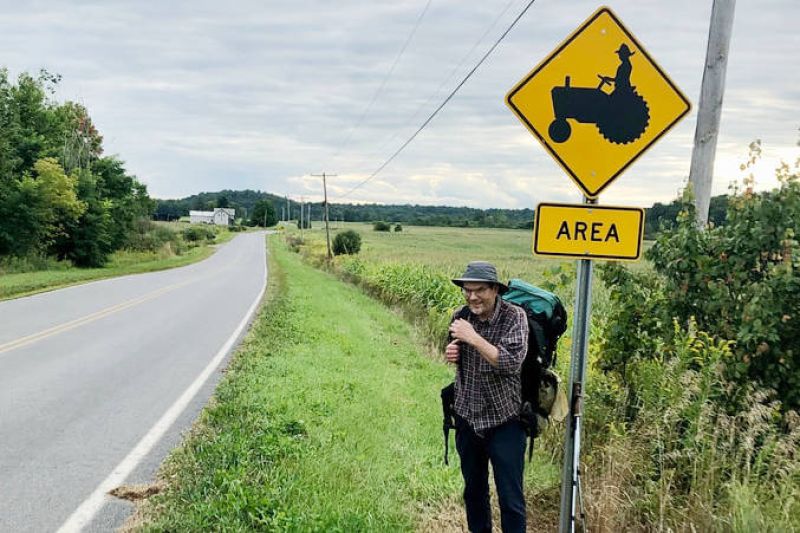Jeff Green | Sep 13, 2023
Jamie Findley has learned a few lessons since August 12. That was the day when he, along with his childhood friend from Morrisburg, began their 'Pilgrimage for Nature' trek from Adirondack Park to Algonquin Park, a 640 kilometre hike through backwoods trails, rail trails, gravel and paved roads.
The Algonquin to Adirondack (A2A) corridor is a link along the Frontenac Arch, between the Boreal and Carolinian forests. The connected ecosystems that transcend national borders were traversed by a Moose, nicknamed Alice. In 1998, Alice was collared and released in Adirondack Park by researchers from the State University of New York. Alice left Adirondack Park and headed north, crossing the Canadian border in the spring of 2000. She somehow negotiated a crossing of the 401, and made it all the way to Algonquin Park. It took Alice two years to make the trek. She later died of unknown causes in Algonquin Park.
For members of the A2A collaborative, Alice's trek symbolises the connections between the terrain along the root, and the collaborative advocates for preserving and restoring natural habitats along the way, not in an unbroken line like a corridor, but as scattered patches, fence lines, river margins, wetlands, and woodlots.
Jamie Findley lives in Chelsea, Quebec, and works for Nature Canada in Ottawa, as a communications person and grant writer. The idea of recreating Alice's journey caught his attention.
“Nobody has done the whole thing, from end to end, and I thought it would be a neat thing to do. Although I work for Nature Canada, 99% of my time is spent at a desk, behind a screen,” he said from a stop in Renfrew earlier this week, “and I wanted to do some tramping, some real tramping.
He enlisted his friend Bill Barclay, who is an orchardist in Leeds Grenville, and a more experienced canoe tripper and backwoods camper, to join him. They had the optimistic goal of travelling 20-25 kilometres a day, carrying 43 pound packs, in order to complete the trek in just over a month.
But travel ended up being much slower than they had planned on.
“There has been a lot of rain in New York State this summer, so the backwoods travel in Adirondack was harder, and slower, than we had planned,” he said this week, “throwing us behind schedule quite a bit.”
That is not to say the trip has not been full of highlights. At one point, after a few hard days in Adirondack Park, they found themselves in a lean-to cabin by a mountain stream.
“It was like a backwoods Hilton,” Jamie recalls. Another time, they hitched a ride in a horse and buggy for 10 kilometres from an Amish family in upstate New York.
“We thought it was okay because we weren't taking a motorised vehicle, and they were nice enough to offer the ride after we visited their farm.”
They also ran into the brutal hot weather last week after entering Ontario, and then Bill needed to leave Jamie in order to deal with the apple harvest in his orchard.
“We knew from the start that he would need to leave when the apples were ready to be picked, so it wasn't a surprise, but it was more pleasant travelling with someone,” said Jamie.
He was joined by another friend, Lisa, for the section from Mallorytown to Delta, during the scorching heat, and they were also traveling along paved roads at the time. But then came a bit of a break.
“Fortunately, in the village of Lyndhurst, we managed to rent a canoe and continued north, paddling out of Lyndhurst Creek and into Lower Beverley Lake, where we eventually reached the little inlet creek that led to Delta,” he wrote in a blog post in early September.”
Now on his own, and realising that his work requirements are piling up, Jamie has come up against a kind of time crunch that would not have troubled Alice the Moose 20 years ago.
“I have had to choose some faster roots along roadways,” he said.
He also borrowed a bicycle from A2A Collaborative supporters in Westport, which enabled him to travel over 70 kilometres in one day.
Other supporters have also ferried his pack for him on a few occasions, so he could travel further with ease on some days.
“The A2A map route meanders quite a bit, and we realised earlier on that we would need to follow some other routes because of time constraints.
He did pick up the K&P Trail, however, in Lanark County, after traveling along Road 36 from Westport to Maberly, and then the Maberly Elphin Road to Snow Road, the only part of his trek that passed through Frontenac County. He took it through Flower Station, up to Calabogie and Renfrew.
The last part of the trek will take him to Barry's Bay and Whitney, and he will end his trip when he reaches the east gate of Algonquin Park.
In addition to being a personal journey, the Pilgrimage for Nature trek has also been an opportunity to promote awareness of the A2A mission, and was supported by Nature Canada as well. Meeting people along the way, promoting the trip on the A2A site and through media, have all been aimed at helping promote the preservation and enhancement of the A2A corridor for all of the wild plants and animals to use, including humans.
More Stories
- The Sun Shines On The Parham Fair
- Creating Your Own Weather, Forever and Ever
- Silver Lake Pow Wow Set For A Big Year
- South Frontenac Receives Substantial Provincial Grant for their Verona Housing Project
- South Frontenac Council Report - August 12
- Dumping To Be Curtailed At Loughborough Waste Site
- Central Frontenac Inching Towards Increasing Severance Opportunities
- Addington Highlands Council Report - August 12
- Addington Highlands Council Report - August 5
- Addington Highlands Council Report - August 12

